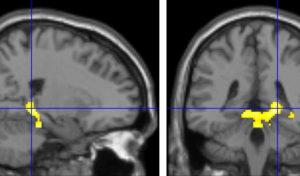 Eating lots of fruits and vegetables (more than 10 servings a day!) is linked to better cognitive functioning in both normal weight and overweight adults (both young and older adults), and may delay the onset of cognitive decline that occurs with aging and also dementia. Overweight and obese older adults with a daily fruit and vegetable consumption of less than 5 servings generally had worse cognitive functioning. Higher levels of physical activity and higher daily fruit and vegetable consumption were both associated with better cognitive functioning. Cognitive functioning generally refers to a person’s ability to reason and think, the mental processes needed to gather and process information, and all aspects of language and memory.
Eating lots of fruits and vegetables (more than 10 servings a day!) is linked to better cognitive functioning in both normal weight and overweight adults (both young and older adults), and may delay the onset of cognitive decline that occurs with aging and also dementia. Overweight and obese older adults with a daily fruit and vegetable consumption of less than 5 servings generally had worse cognitive functioning. Higher levels of physical activity and higher daily fruit and vegetable consumption were both associated with better cognitive functioning. Cognitive functioning generally refers to a person’s ability to reason and think, the mental processes needed to gather and process information, and all aspects of language and memory.
The York University researchers found that fruit and vegetable consumption, physical activity, and BMI or body mass index (normal, overweight, obese) all appear to interact in how a person mentally functions (cognitive functioning), especially as they age. The ideal goal as one ages is to preserve the mind. It appears that eating lots of fruits and vegetables daily (10 or more servings), being physically active (this includes daily walks), and being a healthy weight help with this goal. It helps to also be highly educated (or read books?) so that the brain has a "cognitive reserve",
Why is daily fruit and vegetable consumption (FVC) good for cognitive functioning and the brain? Studies find that daily consumption of fruits and vegetables is strongly associated with a reduced risk of cardiovascular disease, cancer, diabetes and age-related declines. They appear to be "protective" against cognitive decline. The study researchers point out that fruits and vegetables contain high quantities of vitamin C and E, fiber, micronutrients, flavonoids, beta-carotenes and other classes of phytochemicals. These are important in various ways: "they modulate detoxifying enzymes, stimulate the immune system, modulate cholesterol synthesis, and act as antibacterial, antioxidant or neuroprotective agents." NOTE: A serving of fruit is generally 1 medium fruit or 1/2 cup of fruit. A serving of vegetables is 1 cup of raw leafy greens or 1/2 cup of other vegetables. From Medical Xpress:
Healthy living linked to higher brain function, delay of dementia
It's tempting to dip into the leftover Halloween treats, but new research out of York University has found eating plenty of fruits and vegetables, combined with regular exercise, leads to better cognitive functioning for younger and older adults, and may delay the onset of dementia. York U post-doctoral fellow Alina Cohen and her team, including Professors Chris I. Ardern and Joseph Baker, looked at cross-sectional data of 45,522 participants, age 30 to 80+, from the 2012 annual component of the Canadian Community Health Survey.
What they found was that for those who are normal weight or overweight, but not obese, eating more than 10 servings of fruit and vegetable daily was linked to better cognitive functioning. When moderate exercise was added, those eating less than five servings, reported better cognitive functioning. Higher levels of physical activity were linked to the relationship between higher daily fruit and vegetable consumption and better cognitive performance. Those with higher body mass indexes, low activity levels and fruit and vegetable consumption were associated with poorer cognitive functioning.
More details from the original study in the Journal of Public Health: Physical activity mediates the relationship between fruit and vegetable consumption and cognitive functioning: a cross-sectional analysis
Results: Higher BMIs, lower PA [physical activity] and FVC [fruit and vegetable consumption] were associated with poorer cognitive functioning. Additionally, PA statistically mediated the relationship between FVC and cognitive function (Sobel test: t = −3.15; P < 0.002); and higher education levels and daily FVC were associated with better cognitive function (P < 0.001). Conclusion: Higher PA levels were associated with better cognitive functioning in younger and older adults. Also, higher daily FVC and education levels were associated with better cognitive scores.
Individuals who were normal weight or overweight and reported a FVC of >10 servings per day reported better cognitive functioning scores than those who reported <10 servings, as well as those individuals with obesity . As well, both active and inactive individuals who reported a FVC of >10 servings per day had better cognitive scores than those who consumed fewer servings. However, in those who were moderately active, individuals with a daily FVC of <5 or 5–10 servings reported better cognitive functioning than those with a daily FVC of 10 or more servings; this may have resulted because of underestimations of the number of servings of fruits and vegetables actually consumed... Thus, increasing FVC and PA levels as well as having a healthy BMI may aid in the delay of cognitive decline.
Results also indicated that higher education levels along with a daily FVC of five or more servings were associated with better cognitive functioning. Education may be assisting in the process of delaying cognitive decline by increasing cognitive reserve, the ability of the human brain to cope with damage by using different brain processes to retain the ability to function well. Cognitive reserve is developed through intellectual stimulation and translates into a higher volume of connections between neurons and stronger rates of cerebral blood flow.

 An electron micrograph of the measles virus.
An electron micrograph of the measles virus.  Child showing a 4-day measles rash.
Child showing a 4-day measles rash.  Another study finding brain changes from playing tackle football - this time measurable brain changes were found in boys 8 to 13 years old after just one season of playing football. None of the boys had received a concussion diagnosis during the season. The changes in the white matter of the brain (and detected with magnetic resonance imaging (MRI) were from the cumulative subconcussive head impacts that occur in football - the result of repetitive hits to the head during games and practices.
Another study finding brain changes from playing tackle football - this time measurable brain changes were found in boys 8 to 13 years old after just one season of playing football. None of the boys had received a concussion diagnosis during the season. The changes in the white matter of the brain (and detected with magnetic resonance imaging (MRI) were from the cumulative subconcussive head impacts that occur in football - the result of repetitive hits to the head during games and practices. Lead exposure is a big problem for children throughout the United States and the rest of the world - whether lead from plumbing, lead paint, lead solder, and even from nearby mining. There are no safe levels of lead in children (best is zero) because it is a neurotoxicant - thus it can permanently lower IQ scores as well as other neurological effects. More lead gets absorbed if the person also has an iron deficiency than if the person has normal iron levels.
Lead exposure is a big problem for children throughout the United States and the rest of the world - whether lead from plumbing, lead paint, lead solder, and even from nearby mining. There are no safe levels of lead in children (best is zero) because it is a neurotoxicant - thus it can permanently lower IQ scores as well as other neurological effects. More lead gets absorbed if the person also has an iron deficiency than if the person has normal iron levels. More great news about drinking coffee daily - for women. Older women (between ages of 65 to 80 at the start of the study) reporting drinking higher amounts of caffeinated beverages (about 261 mg which is about 2 to 3 cups of coffee per day) had a lower incidence of dementia and cognitive impairment over a 10 year period (as compared to the low caffeine group). The low caffeine group averaged 64 mg of caffeine per day. Other studies also found a reduction in "cognitive decline" in older people with coffee consumption. This study, among others, is more evidence of caffeine being "neuroprotective". NOTE: an 8-ounce cup of brewed coffee contains about 95 mg of caffeine, 8-ounces of brewed black tea contains about 47 mg, a 12-ounce can of carbonated cola contains 33 mg, and 8-ounces of decaffeinated coffee has about 5 mg of caffeine. Science Daily:
More great news about drinking coffee daily - for women. Older women (between ages of 65 to 80 at the start of the study) reporting drinking higher amounts of caffeinated beverages (about 261 mg which is about 2 to 3 cups of coffee per day) had a lower incidence of dementia and cognitive impairment over a 10 year period (as compared to the low caffeine group). The low caffeine group averaged 64 mg of caffeine per day. Other studies also found a reduction in "cognitive decline" in older people with coffee consumption. This study, among others, is more evidence of caffeine being "neuroprotective". NOTE: an 8-ounce cup of brewed coffee contains about 95 mg of caffeine, 8-ounces of brewed black tea contains about 47 mg, a 12-ounce can of carbonated cola contains 33 mg, and 8-ounces of decaffeinated coffee has about 5 mg of caffeine. Science Daily: This study reinforces (once again) that actively playing with toy blocks is good for developing the spatial skills and spatial abilities of children. Other studies have shown that playing with
This study reinforces (once again) that actively playing with toy blocks is good for developing the spatial skills and spatial abilities of children. Other studies have shown that playing with 
.jpg) There are some things we can do that are linked to living longer, such as not smoking and exercising regularly, but could reading books also have such an effect?
There are some things we can do that are linked to living longer, such as not smoking and exercising regularly, but could reading books also have such an effect?  A new study conducted in China found an association between low vitamin D levels and future cognitive decline in older adults. The lower the vitamin D levels at the initial screening (the baseline), the more people with cognitive decline at a 2 year follow-up. There were were no gender differences. (
A new study conducted in China found an association between low vitamin D levels and future cognitive decline in older adults. The lower the vitamin D levels at the initial screening (the baseline), the more people with cognitive decline at a 2 year follow-up. There were were no gender differences. ( A lot of research has shown benefits to being bilingual (
A lot of research has shown benefits to being bilingual (